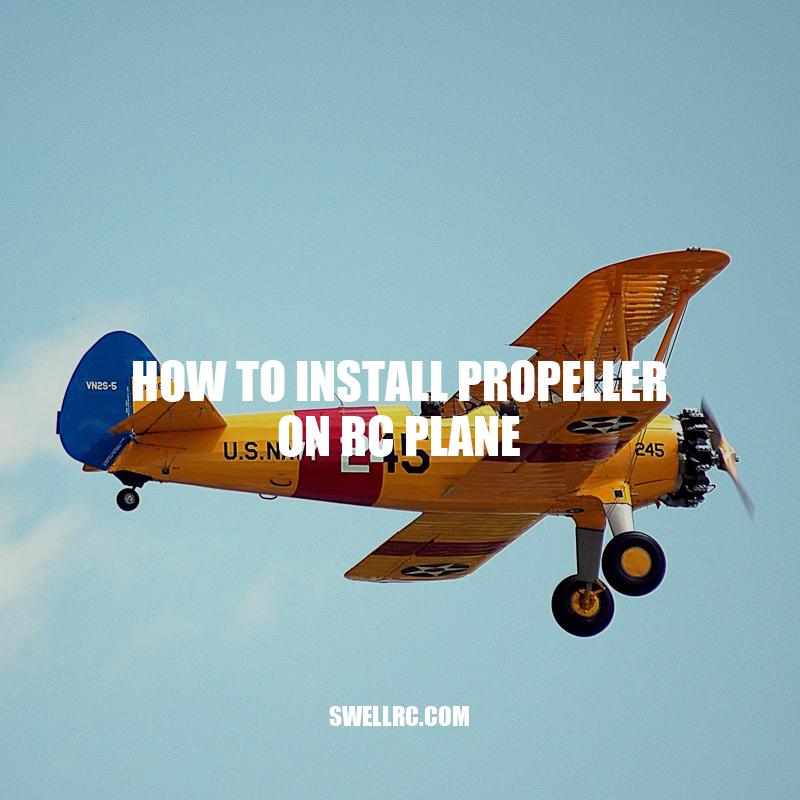RC Plane Propeller Installation Guide
If you’re an RC plane enthusiast, you know that the propeller is an essential component of your aircraft. The propeller converts the motor’s power into thrust, which allows your plane to move forward and stay in the air. Installing a propeller is a crucial step that requires precision, patience, and attention to detail to ensure a successful flight. Installing a propeller is not a complex job, but for beginners, it may seem overwhelming. But worry not! This article is here to guide you through the process of how to install a propeller on an RC plane. You’ll learn about the tools you need, the steps to follow, and tips to ensure a successful installation. By the end of the article, you’ll have the confidence to install a propeller like a pro and enjoy flying your RC plane.
Gather Materials
Before beginning the propeller installation, there are a few tools you will need to have on hand:
- Propeller adapter
- Propeller
- Wrench
It’s important to ensure you have the correct size of each tool, as this can vary depending on the type and size of your RC plane. For best results and to avoid damaging your RC plane, check the instructions that came with your plane to ensure that the propeller matches your plane’s specifications. You can also find information on RC plane forums or manufacturer’s websites for specific installation instructions, recommended tools, and tips from other RC plane enthusiasts. Once you have the necessary materials and tools, you’re ready to start the installation process.
How do you install a propeller?
To install a propeller, follow these steps:
- Remove the old propeller by unscrewing it from the engine shaft.
- Inspect the new propeller and make sure it matches the specifications of the old one.
- Apply anti-seize lubricant to the threads of the shaft.
- Align the keyway on the shaft with the key on the propeller and slide it into place.
- Tighten the propeller nut with a torque wrench according to the manufacturer’s specifications.
- Apply a coat of protective paint to the propeller to prevent corrosion.
- Test the propeller for proper operation.
For more information, consult your engine or propeller manufacturer’s website or refer to their installation instructions.
Remove Old Propeller
Before installing the new propeller, it’s important to remove the old one. Here are the steps to follow:
- Turn off the RC plane’s motor and remove the battery.
- Use a wrench to loosen the propeller nut and remove it from the propeller adapter.
- Gently slide the old propeller off the adapter.
- Inspect the adapter and motor shaft for any wear or damage. If any issues are detected, consider replacing the adapter or motor shaft for optimal performance.
It’s important to avoid damaging any parts during removal or installation of the propeller. Also, keep in mind that the propeller nut may be secured tightly, so be prepared to use some force to loosen it.
If you’re having difficulty with the propeller installation, consider seeking help from an experienced RC plane enthusiast or checking online forums and instructional videos. Many RC plane manufacturers also offer product support and customer service resources on their websites or social media pages.
Did You Know?
Did you know that the shape, size, and pitch of the propeller can significantly impact the performance of an RC plane? By choosing the right propeller, you can achieve greater speed, stability, and lift. Check your RC plane’s specifications or consult with an expert to find the best propeller for your needs.
RC Plane Propeller Sizes
Here’s a quick reference guide for common RC plane propeller sizes:
| Diameter (Inches) | Pitch (Inches) |
|---|---|
| 5 | 2.5 |
| 6 | 4 |
| 7 | 3.5 |
| 8 | 4.5 |
How do you remove a nut propeller?
To remove a nut propeller, you first need to gather a few tools before starting. Here are the steps to follow:
- Turn off the engine and disconnect the battery.
- Remove the propeller cotter pin.
- Loosen and remove the propeller nut using a prop wrench.
- Tap the rear of the propeller using a soft-faced hammer to break the prop loose.
- Carefully pull out the propeller from the propeller shaft.
Remember to take safety precautions to avoid injuries during the process. If you need further guidance, consult your boat’s manual or seek professional help.
For more information on boat maintenance and repair, visit websites such as BoatUS, West Marine, and Boating World.
Install Propeller Adapter
Before installing the new propeller, the propeller adapter must be installed properly. Here are the steps to follow:
- Align the propeller adapter with the motor shaft.
- Push the adapter onto the shaft until it is secure, but don’t force it.
- Use the appropriate wrench size to tighten the screw that holds the adapter in place.
- Ensure that the adapter is centered and snug on the shaft.
It’s important to use the correct size wrench to secure the propeller adapter to avoid damaging the adapter or motor shaft. Also, avoid over-tightening the screw to prevent it from breaking or stripping.
If you’re having difficulty with the propeller installation, consider seeking help from an experienced RC plane enthusiast or checking online forums and instructional videos. Many RC plane manufacturers also offer product support and customer service resources on their websites or social media pages.
Propeller Adapters
Propeller adapters are essential components for installing propellers on RC planes. There are many types and sizes of adapters to choose from, depending on the specific needs of your RC plane. Some popular brands of adapters include Aluminum Spinner Shafts, Dubro Products, Great Planes, RC Zinc Alloy Propeller, and Tru-Turn. Consider consulting with an expert or conducting research to find the best adapter for your RC plane.
How Propellers are Fitted to the Shaft?
Propellers are attached to the engine’s main shaft using a series of nuts and bolts. Here’s the step-by-step process that is typically followed:
- The propeller is placed over the shaft and aligned carefully.
- A keyway is made to ensure that the propeller sits securely on the shaft.
- A cotter pin is inserted into the shaft’s end to ensure that the propeller remains in place.
- Nuts and bolts are tightened to the recommended torque.
- Any protective covers or guide pins are installed if required.
It’s important to note that this process may vary depending on the type of propeller and engine being used. If you’re not sure how to install your propeller correctly, seek the help of a professional mechanic.
If you’re in need of high-quality propellers or any other boating equipment, check out websites such as West Marine or Overton’s. They offer an extensive range of products at affordable prices.
Install Propeller
Once the propeller adapter is securely fastened to the motor shaft, it’s time to install the propeller. Follow these steps:
- Slide the propeller onto the adapter, making sure it aligns with the adapter shaft.
- Use the appropriate propeller nut to attach the propeller to the adapter.
- Use a wrench to tighten the nut until it’s snug, but don’t over-tighten.
It’s important to ensure that the propeller is not too loose or too tight to avoid any mishap during flight. A loose propeller could fall off during flight, while an over-tightened propeller could damage the motor shaft.
If you want to upgrade your RC plane’s performance, you can also consider using high-performance propellers. Some popular options include carbon fiber propellers, wooden propellers, and electric propellers designed for specific RC planes. Be sure to research and consult with experts before making any upgrades or changes that could affect the performance and safety of your RC plane.
Propeller Safety
It’s essential to take safety precautions while installing a propeller on an RC plane. Some safety tips include:
- Wear protective eyewear and gloves to protect yourself from any flying debris or sharp edges.
- Ensure the plane is securely fastened to a work surface or bench to prevent it from moving during installation.
- Always disconnect the plane’s battery to avoid any accidental engagement of the motor or propeller.
- Be mindful of the propeller’s spinning blade during installation and test runs.
By following these safety tips, you can reduce the risk of injury or damage to your RC plane.
What is the propeller of a RC plane?
The propeller is the component of an RC plane responsible for producing thrust and generating lifting force during flight. It works by spinning rapidly and pulling air behind it, which propels the plane forward. The propeller size and type can greatly affect the performance and speed of an RC plane.
There are many different types of propellers available, including two-bladed, three-bladed, and four-bladed varieties. It’s important to choose the right propeller for your RC plane based on its size, weight, and power source.
If you’re looking for information on RC planes and their components, websites such as RC Groups and RC Planet offer a wealth of resources and products for enthusiasts of all levels.
Test the Propeller
Before flying your RC plane, it’s essential to test the propeller to ensure everything is working correctly. Follow these steps:
- Connect the RC plane to the battery and run the motor at a low speed.
- Observe the propeller to check if it’s spinning smoothly without wobbling or vibrating.
- Use a balancing tool to make necessary adjustments to the propeller’s weight distribution if there are any vibrations.
- Check if the propeller is not too loose or too tight. A properly installed propeller should rotate smoothly without any wobbling or shaking.
If you notice any issues during the test, try tightening or adjusting the propeller before attempting to fly the RC plane. Take your time and be thorough during this step to avoid any accidents, damage, or injuries during flight.
Some websites offer helpful tips and tutorials for installing propellers, such as RC Universe, RC Groups, and RC Model Reviews. Additionally, there are various products available online, such as propeller balancing tools, propeller adapters, and high-performance propellers that can enhance the flight performance of your RC plane. Remember to purchase from trusted sources and consult with experts before making any upgrades or changes to your RC plane.
How do you inspect propeller?
To inspect a propeller, follow these simple steps:
- Visually inspect the propeller for dents, nicks, and cracks.
- Check to see if the blades are bent or misaligned.
- Run your finger along the leading edge of each blade to detect any burrs or sharp edges that could indicate damage.
- If there is any damage or wear, you must repair or replace the propeller.
There are many websites and products available to assist with propeller inspection and repair. It is recommended to consult a professional if you are unsure about the condition of your propeller.
Conclusion
Installing a propeller on your RC plane can be a challenging task, but with the proper steps, you can ensure a safe and efficient flight. Remember to gather all necessary materials, check the instructions, and be careful when removing or installing parts. Test the propeller to ensure everything is working correctly before flying the RC plane.
By following the steps outlined in this article, you can install a propeller on your RC plane with confidence. However, always seek help or consult with experts when you encounter difficulties, especially when making severe changes or upgrades to your RC plane.
Overall, installing a propeller on your RC plane is a crucial step that requires patience, attention to detail, and care. With the right mindset and tools, you can complete this task successfully and enjoy a safe and thrilling flight experience on your RC plane.



